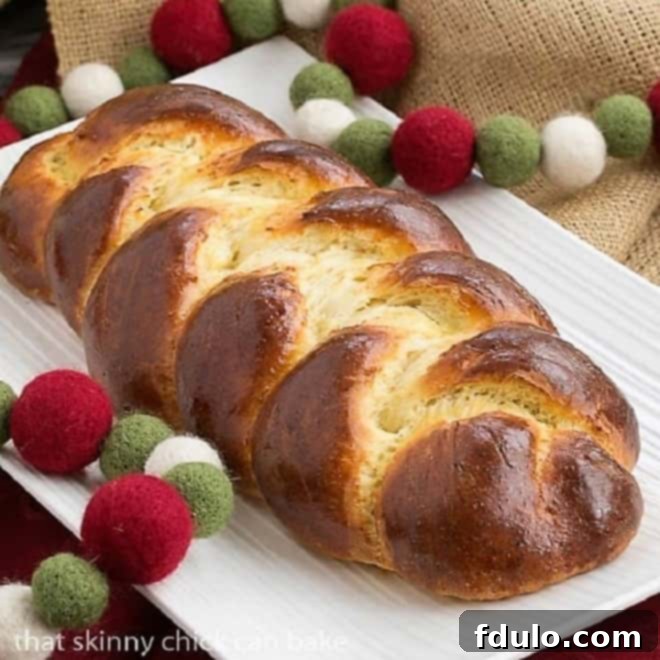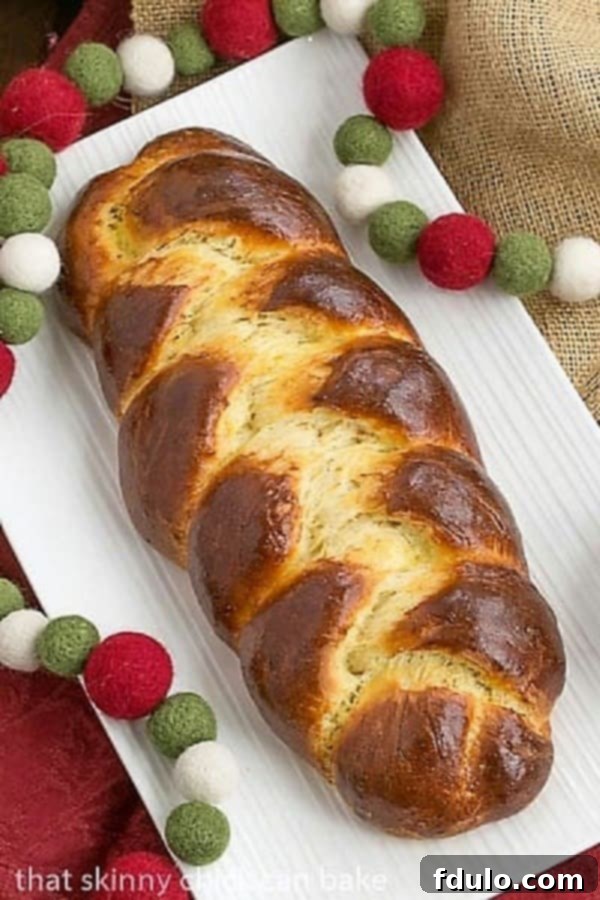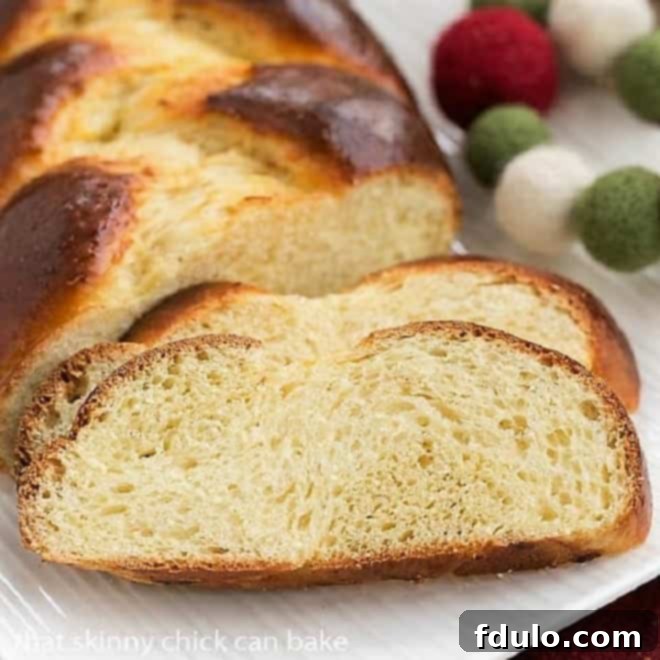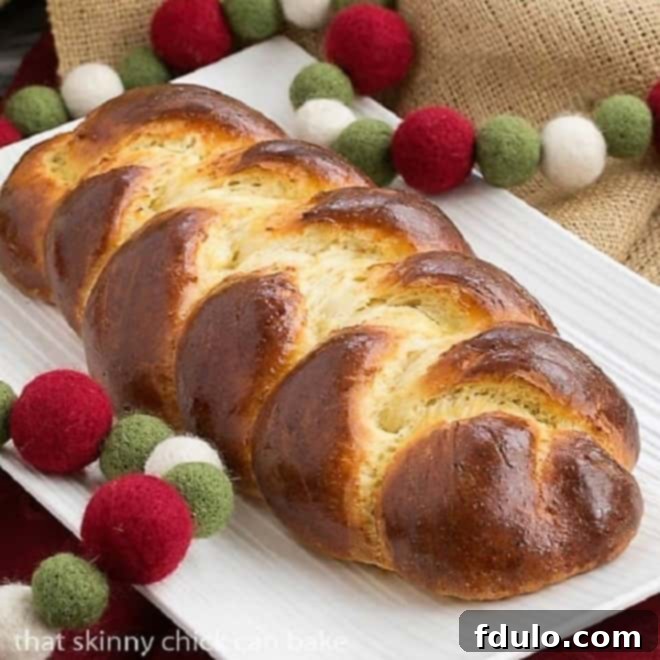Swiss Butter Braid, famously known as Butterzopf in its homeland, is a truly exquisite plaited bread that perfectly balances a delicate sweetness with a rich, tender crumb. This magnificent yeast bread is a cherished specialty, making it ideal for festive occasions, holiday gatherings, elegant brunches, or simply when you desire to indulge in a slice of pure, yeasty deliciousness. Prepare to fill your kitchen with the irresistible aroma of freshly baked bread as you embark on crafting this beautiful loaf.
Originating from the picturesque landscapes of Switzerland, this buttery, braided bread transcends a mere baked good; it’s a culinary tradition, a symbol of warmth and hospitality. While often reserved for special moments elsewhere, for the Swiss, Butterzopf is a common, beloved part of their Sunday breakfast ritual, bringing families together over its golden-brown beauty.

Why This Swiss Butter Braid Recipe is a Must-Try
Baking homemade bread is always a rewarding experience, but preparing a loaf of Swiss Butter Braid takes that joy to an entirely new level. This particular Butterzopf recipe stands out for several compelling reasons:
- **A Feast for the Eyes and Palate:** There’s an undeniable charm to braided bread recipes. The intricate plaiting instantly elevates the loaf, making it look incredibly festive and sophisticated. While simple in its ingredients, the visual appeal of a perfectly braided Butterzopf transforms it into a stunning centerpiece, worthy of any holiday table or special gathering.
- **Everyday Elegance:** While the Swiss may consider Butterzopf an everyday bread, its rich flavor and beautiful appearance make it feel like an extraordinary treat for many. It’s an accessible luxury that brings a touch of gourmet bakery quality right into your home, without requiring advanced baking skills.
- **Unforgettable Flavor Profile:** This recipe delivers a delightful sweetness, carefully balanced by a generous amount of butter. The inclusion of two whole eggs plus an extra yolk contributes immensely to the bread’s incredible richness, creating a wonderfully tender crumb and a beautiful golden hue that hints at the deliciousness within. It’s a flavor that evokes comfort and celebration, making it an ideal candidate for any holiday meal, from Christmas to Easter, or a simple weekend brunch.
- **Versatility Beyond the Loaf:** Should you be lucky enough to have any leftovers – a rare occurrence, we warn you! – they transform into culinary magic. Imagine thick slices of this tender Butterzopf soaking up an egg custard for the most decadent French toast you’ve ever tasted. Or perhaps cube it for a luxurious bread pudding. The thought alone is enough to make anyone swoon! This Butter Braid has consistently been a massive hit with everyone who tries it.
- **The Joy of Homemade:** There’s nothing quite like the pride of pulling a warm, fragrant loaf of homemade bread from your oven. This recipe allows you to experience that profound satisfaction, impressing your loved ones with your baking prowess and filling your home with an aroma that signals pure comfort.
Mastering Your Ingredients for Perfect Butterzopf
Achieving the perfect Swiss Butter Braid begins with understanding the role each ingredient plays. This recipe relies on readily available kitchen staples, ensuring that even novice bakers can achieve spectacular results.
Essential Ingredients:
- **Milk:** Provides tenderness and moisture to the dough. For the richest results, whole milk is recommended, but other milk varieties can also be used.
- **Sugar:** Beyond adding sweetness, sugar acts as food for the yeast, aiding in its activation and contributing to the bread’s golden crust. The amount in this recipe creates a perfectly balanced sweet yeast bread.
- **Melted Butter:** The star of “Butterzopf”! High-quality melted butter is crucial for the bread’s signature richness, flavor, and tender texture. Using good butter makes a noticeable difference in the final product.
- **Eggs plus one Yolk:** Eggs are vital for structure, richness, and imparting a beautiful golden color to the dough. The extra egg yolk further enhances the bread’s luxurious texture and contributes to its vibrant hue.
- **Instant Yeast (One Envelope):** This leavening agent is what gives the bread its airy structure. Instant yeast is convenient as it can be mixed directly with dry ingredients without prior proofing. For consistent and reliable results, a high-quality brand like Red Star Platinum Yeast is preferred, known for its superior performance and flavor.
- **Salt:** A small but mighty ingredient, salt is essential for balancing the sweetness, enhancing all the other flavors, and controlling yeast activity. Don’t skip it!
- **All-Purpose Flour:** The foundation of our bread. While specific bread flours can be used, all-purpose flour works wonderfully here, providing a tender yet sturdy crumb.
- **Additional Egg for Glaze:** An egg wash applied before baking gives the Butterzopf its characteristic glossy, golden-brown crust.

Expert Tips for Crafting Your Perfect Butterzopf
Baking a braided yeast bread like Butterzopf is a rewarding process, and these tips will help ensure your success from start to finish, yielding a beautifully risen, perfectly baked loaf.
- **Embrace Your Mixer:** If you’re fortunate enough to own a heavy-duty stand mixer (such as a KitchenAid), make good use of its dough hook attachment. It will significantly cut down on kneading time and effort, developing the gluten necessary for a tender, chewy crumb. While hand kneading is always an option, a mixer provides consistent and thorough kneading.
- **Flavor Enhancements (Optional):** Renowned baker Nick Malgieri suggests folding in 1½ cups of raisins, currants, or other diced dried fruit into the dough before braiding. This can add a wonderful chewiness and additional pockets of sweetness, enhancing the bread’s complexity.
- **The Art of Slow Proofing:** Resist the urge to rush the proofing process by placing the dough in an excessively warm environment. An ideal temperature range of 80-90 degrees Fahrenheit (27-32°C) is perfectly adequate. Any warmer, and the yeast may over-activate, leading to a less optimal texture and potentially a “yeasty” off-flavor. A slower, more controlled rise allows the flavors in the dough to develop more fully, resulting in a more delicious and nuanced Butterzopf.
- **Mastering the Braid:** Braiding bread is very much like braiding hair; once you grasp the rhythm, it becomes surprisingly simple.
- Start by pinching three strands of equal length firmly together at one end to secure them.
- Cross the left strand over the middle strand. The left strand now becomes the new middle.
- Next, cross the right strand over the new middle strand. The right strand now becomes the new middle.
- Continue this alternating pattern – left over middle, then right over middle – until you have braided most of the rope.
- Once there isn’t enough length left to continue braiding comfortably, pinch the ends of the strands firmly together.
- Tuck these pinched ends neatly underneath the loaf to create a smooth, finished appearance.
- **Don’t Braid Too Tightly:** While a firm braid is good, avoid braiding the dough too tightly. If the strands are overly compressed, the bread may split apart during baking as it expands, ruining its beautiful form. Allow for a little space for expansion.
- **The Crucial Second Rise:** After braiding, allow the loaf to proof (rise) again. This second rise is vital for developing a light, airy texture. Once it has nearly doubled in size, it’s time for the final touches.
- **The Golden Glaze:** Before baking, whisk one egg and gently brush it over the entire surface of the braided loaf. This egg wash contributes to the Butterzopf’s iconic glossy, golden-brown crust.
- **Baking to Perfection:** Preheat your oven to the specified temperature. Bake the bread until it’s deeply golden and cooked through. If you notice the crust browning too quickly after about 30 minutes, loosely tent the loaf with aluminum foil. This will prevent scorching while allowing the interior to finish baking.
- **Testing for Doneness:** To ensure your Butterzopf is perfectly baked, gently press on the sides of the loaf – it should feel firm. Another classic test is to rap on the bottom of the loaf; a hollow sound indicates it’s done. For ultimate precision, an internal temperature of around 200-210°F (93-99°C) is ideal for yeast bread.
- **Patience is a Virtue (Cooling):** Once out of the oven, transfer your magnificent Butterzopf to a wire rack. Allow it to cool completely, or at least significantly, before slicing. Slicing hot bread can result in a gummy texture. Cooling allows the internal structure to set properly.

Frequently Asked Questions About Swiss Butter Braid
In Switzerland, Butterzopf holds a special place, most commonly enjoyed as a delightful addition to Sunday morning breakfast. It’s also a popular choice for festive meals and family gatherings.
While both Butterzopf and Challah are beautiful braided breads, their key distinction lies in their fat content. Challah is traditionally made with oil (often olive oil), adhering to kosher dietary laws. Butterzopf, as its name suggests (“Butter braid”), always uses butter, which gives it a distinct richness and flavor.
The history of Butter Braid, or Butterzopf, dates back to the mid-15th century. Interestingly, its origin is tied to a unique tradition where a woman would cut off her braid and place it in her husband’s grave during his burial. Over time, this symbolic act evolved, and the actual braid was eventually replaced by this braided loaf of bread, symbolizing remembrance and love.
Like most freshly baked bread, Butterzopf is truly at its best on the day it’s made, still slightly warm from the oven. However, it can be stored successfully to maintain its deliciousness:
- **Room Temperature:** Keep it in an airtight container or a bread box for 3-4 days.
- **Refrigerator:** For extended freshness, store it in an airtight container in the refrigerator for up to a week.
- **Freezer:** For long-term storage, Butterzopf freezes beautifully. Wrap the cooled loaf tightly in plastic wrap, then in aluminum foil, and store in the freezer for up to 3 months. Thaw at room temperature and refresh in a warm oven for a few minutes before serving.
Creative Ways to Enjoy Your Butterzopf
Beyond simply slicing and serving, your homemade Swiss Butter Braid can be transformed into even more delectable treats. Its sweet and buttery profile makes it incredibly versatile:
- **The Ultimate French Toast:** As mentioned, stale Butterzopf makes for an unparalleled French toast. The richness of the bread perfectly complements a simple egg and milk batter.
- **Luxurious Bread Pudding:** Cube any leftover Butterzopf, soak it in a custard, and bake for a comforting and indulgent dessert.
- **Sweet Croutons:** Cut the bread into cubes, toss with a little melted butter and cinnamon sugar, then bake until crisp. Perfect for topping fruit salads or ice cream.
- **Sandwich Base:** While typically served plain, a slice of Butterzopf can be a wonderful base for delicate sweet sandwiches, perhaps with a thin layer of cream cheese and berries.
- **Toasted Perfection:** A lightly toasted slice of Butterzopf, spread with butter, jam, or honey, is a simple yet exquisite breakfast or snack.
You May Also Love These Bread Recipes:
If you’ve enjoyed baking this Swiss Butter Braid, you might be inspired to try other wonderful bread creations. Here are some favorites:
- Stollen Wreath from Cake Duchess
- Braided Easter Bread
- Plaited Easter Bread
- Easy King Cake
- Spinach Onion Braid
- Explore more Bread Recipes
Stay connected and share your culinary adventures! Follow on Instagram, Facebook, and Pinterest. Don’t forget to tag me when you try one of my recipes! If you love the results, please consider giving it a 5-star rating in the recipe card below.

Swiss Butter Braid (Butterzopf)
30 minutes
30 minutes
1 hour
1 loaf (approx. 12 servings)
A sweet, buttery, and beautifully braided loaf, perfect for holidays, entertaining, or a delightful weekend treat. This authentic Swiss Butterzopf recipe is adapted from Nick Malgieri.
Highly rated by 46 bakers!
Ingredients
- ½ cup milk (whole milk recommended for richness)
- ½ cup granulated sugar
- 6 tablespoons unsalted butter, melted
- 2 large eggs plus 1 large egg yolk (at room temperature)
- 2 ½ teaspoons (or one standard envelope) instant yeast (Red Star Platinum yeast preferred)
- ¼ teaspoon fine sea salt
- 2 ¾ cups all-purpose flour (plus more for dusting)
- 1 large egg, for egg wash glaze
Instructions for Swiss Butter Braid
- In the bowl of a stand mixer fitted with the paddle attachment, combine the milk, sugar, and melted butter. Mix on low speed until well combined.
- Add the 2 eggs and the extra egg yolk to the mixture, mixing until incorporated. Then, sprinkle in the instant yeast and mix briefly. Slowly add the salt, followed by the all-purpose flour, mixing on low speed until a soft dough forms.
- Switch to the dough hook attachment (if using a stand mixer). Continue to mix and knead for about 2 more minutes, or until the dough is smooth and elastic. Alternatively, turn the dough out onto a lightly floured surface and knead by hand for 8-10 minutes. The dough will be soft and slightly sticky.
- Lightly grease a large bowl. Place the dough in the greased bowl, turning once to coat. Cover the bowl tightly with greased plastic wrap or a clean kitchen towel. Let the dough rise in a warm, draft-free room (ideally 80-90°F / 27-32°C) for 1 to 1½ hours, or until it has doubled in bulk.
- Once risen, gently deflate the dough. Transfer it to a lightly floured surface and divide it into 3 equal pieces. Roll each piece into a uniform rope, approximately 15 inches (38 cm) long. Arrange the three ropes parallel to each other. Pinch one end of the ropes firmly together. Begin braiding: cross the left rope over the middle, then the right rope over the new middle. Continue this pattern until the braid is complete. Pinch the other end of the ropes together and tuck both ends neatly underneath the loaf.
- Carefully transfer the braided loaf to a baking sheet lined with parchment paper. Cover it loosely with greased plastic wrap or a light kitchen towel. Let it rise again in a warm place for another 1 to 1½ hours, or until it has visibly doubled in size and looks puffy. This second rise is crucial for a light texture.
- Preheat your oven to 375ºF (190ºC) during the final stages of the second rise. In a small bowl, whisk the remaining egg for the glaze until well combined. Gently brush the egg wash evenly over the entire surface of the risen braided bread.
- Bake for 30 minutes, or until golden brown and cooked through. If the loaf begins to brown too quickly during the last 5-10 minutes of baking, loosely tent it with aluminum foil to prevent over-browning. The bread is done when it sounds hollow when tapped on the bottom.
- Remove the Butterzopf from the oven and transfer it to a wire rack to cool completely before slicing and serving. Cooling ensures the internal structure sets properly.
Chef’s Notes
Total time indicated does not include the essential proofing times. This recipe has been adapted and inspired by Nick Malgieri’s exceptional cookbook, How to Bake. For optimal flavor and texture, allow for a slow and steady rise during both proofing stages.
Recommended Baking Products
As an Amazon Associate and member of other affiliate programs, I earn from qualifying purchases.
- USA Pan Bakeware Half Sheet Pan, Warp Resistant Nonstick Baking Pan, Made in the USA from Aluminized Steel – 1050HS
- Set of Glass Mixing Bowls
- KitchenAid KSM150PSER Artisan Tilt-Head Stand Mixer with Pouring Shield, 5-Quart, Empire Red
Nutrition Information:
Yield:
12 servings
Serving Size:
1 slice
Approximate Amount Per Serving:
Calories: 226
Total Fat: 8g
Saturated Fat: 4g
Trans Fat: 0g
Unsaturated Fat: 3g
Cholesterol: 78mg
Sodium: 115mg
Carbohydrates: 33g
Fiber: 1g
Sugar: 11g
Protein: 5g
HOW MUCH DID YOU LOVE THIS RECIPE?
Please leave a comment on the blog or share a photo on Pinterest
